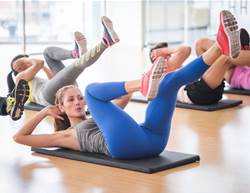When you’re working hard to get fit and lose weight safely, you want a regular routine that provides results. Good news: There are many small changes that you can make to lead a healthier life, including adding some of the best exercises for weight loss to your workout routine.
For healthy weight loss, you’ll want to incorporate “at least 150 minutes a week of moderate aerobic activity or 75 minutes of vigorous aerobic activity a week,” explains Jim White, dietitian and exercise physiologist.
Adding strength training exercises that hit all major muscle groups two to three times per week is also a great place to start, White adds.
It’s also important to include healthy eating in your weight loss game plan. Proper nutrition will help fuel your workouts and can aid in burning body fat more efficiently.
“All in all, both exercise and nutrition are very important in helping you become the best you possibly can, reaching your goals physically, and helping your mental state of mind,” White adds.
But what kind of exercise burns calories most efficiently? These best exercises for weight loss, recommended by experts, will guide you in the right direction.
1. Running

Whether you love or hate it, running is one of the best and simplest ways to burn kilojoules—and you don’t need a treadmill to do it. Just lace up your shoes and hit the road.
Running in intervals—speeding up and slowing down your pace—will help make the minutes and kilometres go by quickly. Run in fartleks, which means speed play in Swedish, where you pick up the pace every other street light you pass, and then slow down after you pass the next one.
The best way to burn kilojoules while running is to vary your workouts, says running coach Natalie Dorset.
“If you’re doing the same workout week after week, your body won’t have anything to adapt to. Vary the speed within a workout, do some bursts of faster running, but also mix up the types of runs you do. Whether it’s slow and steady, comfortable and hard, or intervals, variety is the key to constant adaptation.”
“Sprinting helps engage the core and offers shorter durations of runs at higher intensities,” adds personal trainer Chris Ryan.
He also notes that running slow is relatively easy on your body as far as exertion is perceived, but running fast at 80% of your capability is even harder, pushing your body even more to its limits. This conditions your body to get used to this kind of stress.
“There is definitely something to be said about getting comfortable being uncomfortable on your runs, so skip the road and head to a track or soccer field for some sprints next time,” he says.
TRY a Fartlek sprinting routine: Start out with a five-minute jog. Then alternate between 10-second sprint intervals and 50-second moderately-paced jogs.
Use that jog to catch your breath, then hit the next sprint hard. Perform these intervals for 15 minutes, then end with a five-minute jog. When you start feeling stronger in your runs, try upping the sprint effort to 20 seconds with 40 seconds of jogging.
2. Hiking

Walking and hiking are both great forms of exercise, White explains. However, if you’re looking to increase your kilojoules burned walking and increase the weight loss benefits, hiking may be a better option.
“Hiking will be more beneficial to you [for] losing weight compared to walking,” White explains.
This is because hiking is a bit more challenging than walking on a flat path. As your body works harder trekking over the harsher terrain, hills, and elevations, it will help with strengthening leg and core muscles. It will also increase balance and stability, and burn more kilojoules.
“All in all, hiking is a great way to get outdoors and be surrounded by nature while reaping the benefits of exercise,” White explains.
3. Jump Rope

If the last time you held a jump rope was in school, it’s time to get back into the swing of things. This kilojoule-busting workout can burn about 1,330 calories (for a 63kg woman) every 30 minutes—and your heart isn’t the only muscle that’s working hard.
Jumping rope is a full-body workout. It fires up your quads and glutes to help you explode from the ground, and engages your core to keep you upright and stable as you land back down.
Jumping rope also involves a little arm and shoulder action, as they remain tight while the rope movement comes from the wrists.
“Jumping rope is a great way to burn calories while improving cardiovascular health, all-over-toning, and coordination, and it will help build power while lowering your risk of injury,” Dorset says.
TRY this Crossrope routine: Start with 60 seconds of freestyle jump roping. You can jump with two feet, one foot, alternate, skip, or twist your hips. You can have some fun with this one.
Next, put down your rope and do 30 seconds of mountain climbers. Return for 60 seconds of freestyle jump roping. End with 30 seconds in a plank. Rest for two minutes and repeat the cycle. Complete three rounds.
4. Strength Training

Strength training can help you build lean muscle mass and rev up your metabolism, which starts to slow down once you hit your 30s.
“The more muscle you have, the less fat you have since your metabolism runs higher,” Ryan says. A higher metabolism leads to more kilojoules burned and more fat lost.
Resistance training also helps prevent osteoporosis. According to Wolff’s law, bone grows in response to the forces that are placed upon it. So if you lift heavier, your bones grow stronger as a response.
“It also works on force production to maintain shoulder, hip, and spine strength, which enables your whole body to lead to a healthier life long into your later years,” Ryan says. Deadlifts, anyone?
TRY a basic dumbbell circuit: Pick up one dumbbell and complete 10 squats, 10 dumbbell rows per arm, and 10 of any push-up variation of your choice. Move right into the next exercise as you finish the reps. Do three rounds. Rest for two minutes in between each round. To make it more challenging, increase the weight of the dumbbell or use two.
5. Kickboxing
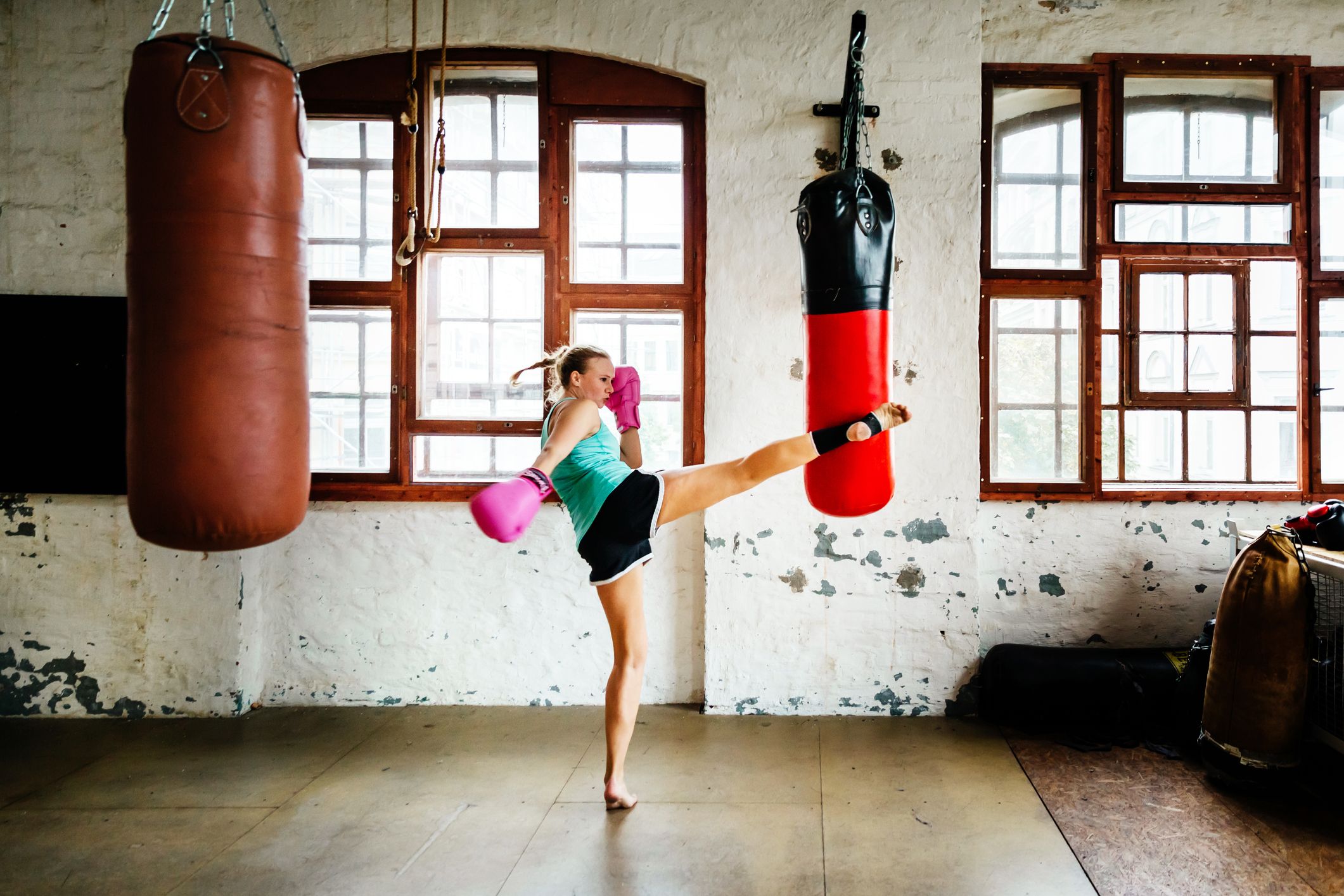
Kickboxing is a great way to burn kilojoules, sculpt muscles, and get in some serious stress relief!
By driving power from your legs, your arms are able to throw major jabs, crosses, hooks and uppercuts, making it a full-body exercise. It will also test your coordination and endurance—all essential things that make you a better athlete in and out of the ring.
“Kickboxing works your core, legs, and specifically your obliques to newfound glory by pumping up your heart and lungs,” Ryan says.
“It also helps you work on balance, coordination, and proprioception (body awareness of movement). It truly is a mind-meets-muscle exercise if there ever was one.”
TRY five kicking combos from the DailyBurn: Take these combos and perform eight reps of each as long as you can for 30 minutes. Rest as needed. Play your favourite fight music and stay strong.
6. Spinning
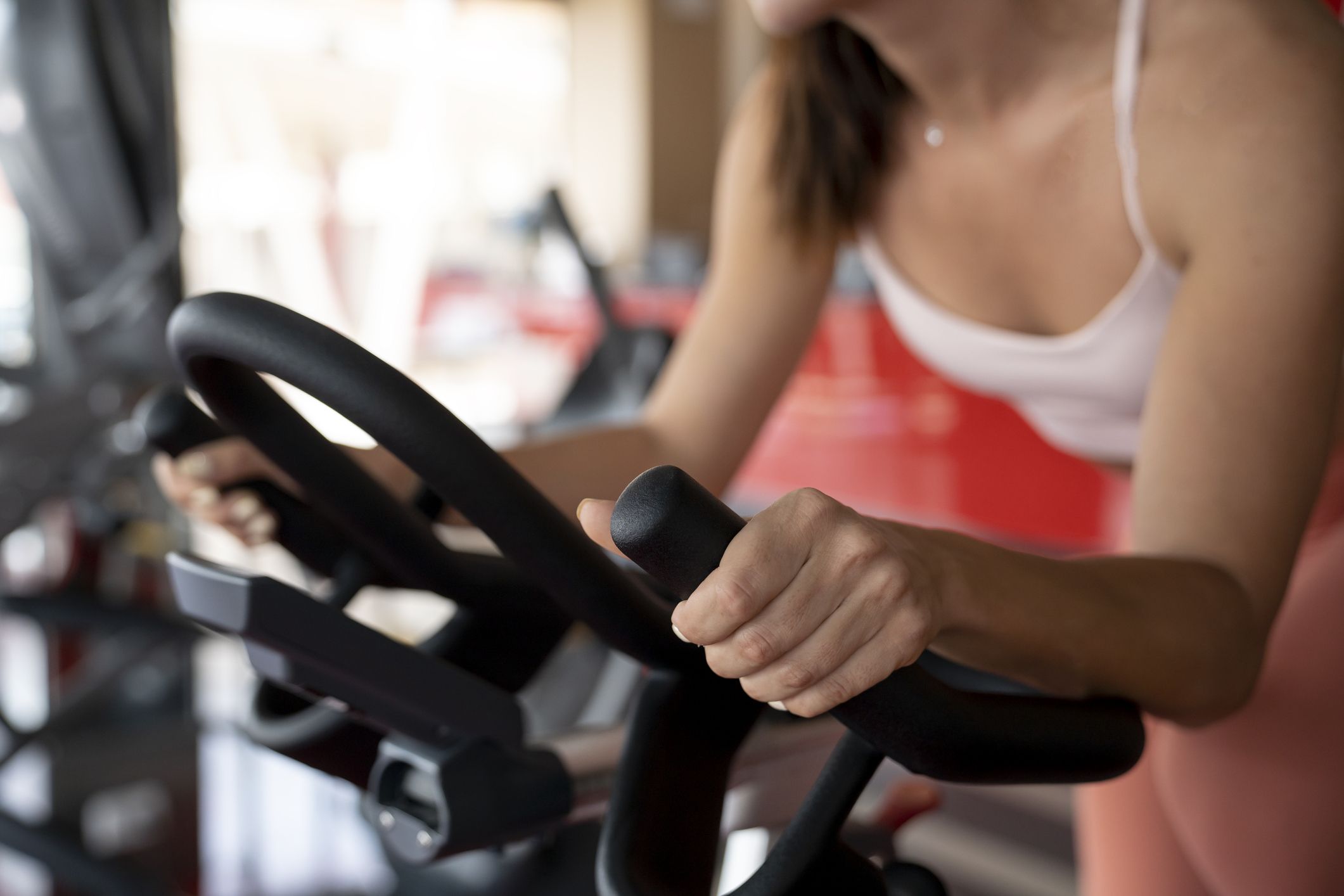
Spinning, whether it’s on an actual bike or a stationary bike, is one of the best ways to burn calories and build endurance.
Spinning is a great weight-loss activity that is relatively low impact and targets the biggest, strongest muscles in the body, the glutes and hamstrings, says Ryan.
“When you engage your biggest muscles, you set off hormones to produce more muscles, similar to strength training, which helps to burn fat across your whole body,” he adds.
If you don’t like running, spinning is a low-impact alternative that’ll crank up your heart rate.
But there’s more to pushing the pedal than speed. By practicing good form and engaging your core as well as your thighs and glutes, spinning can be a full-body workout.
Whether you’re doing a heavy climb or sprinting on the bike, your core is the key to spinning efficiently and quickly. And as you drive your foot down with each stroke, it’s all about squeezing your inner thighs.
TRY a spinning interval routine: Warm up on the bike for 10 minutes. Go as hard as you can for 30 seconds; pedal easy for 60 seconds. Repeat four times except after the fourth work interval, pedal easy for four minutes.
Repeat the whole cycle three more times for a total of 37 minutes of exercise.
7. HIIT (High Intensity Interval Training)
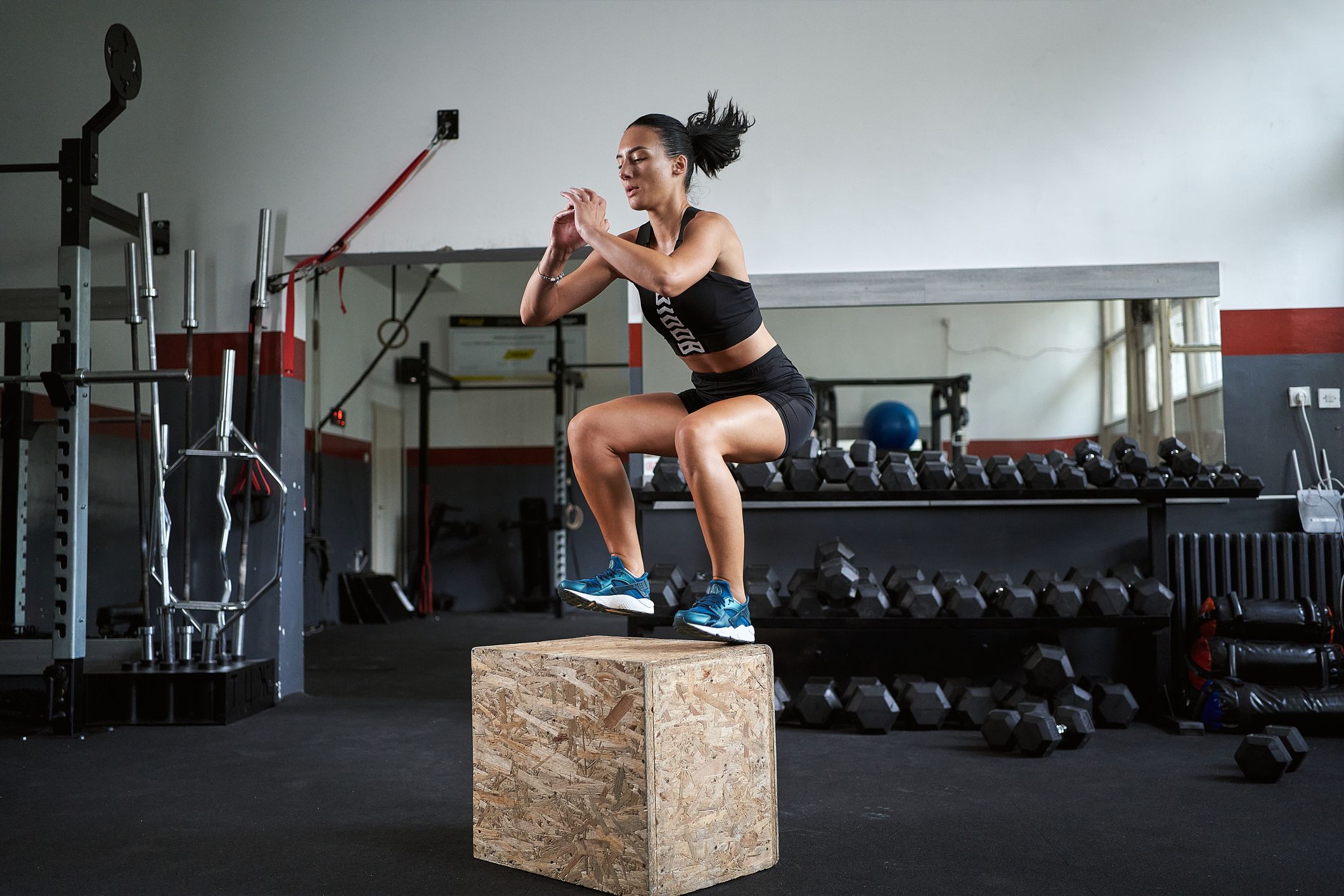
HIIT workouts are, by far, one of the most effective ways to burn kilojoules and hike up your metabolism. The best part is, these workouts don’t have to last very long.
Some HIIT workouts can last for only 10 minutes, but it’s only effective if you push your body to its limits with all-out energy. Research has shown that HIIT can help burn belly fat.
Throughout, form is key. “Even though you are moving through movements at high intensities, you still need to make form paramount to avoid injury,” Ryan says.
“Think less about the load/tension or weight intensity and focus more on completing the reps and sets in a sound manner and building load safely.”
TRY a 20-minute HIIT workout to rev up your metabolism.
8. Rowing

If you haven’t used your gym’s rowing machine, you’re missing out on one of the best pieces of cardio and strength equipment. Working your quads, glutes, hamstrings, core, arms, and back, you get a total-body workout that’ll have you pouring sweat.
Contrary to what most people think, the power of rowing mostly comes from your legs—not your arms. Engaging your quads and glutes, you drive your legs back to pull the handle toward your chest.
“Rowing is a great weight-loss tool because it incorporates the best out of the cardio and strength worlds, with a focus on pulling and opening up the hips and shoulders. At the same time, you’re working your heart and lungs,” Ryan says.
If you have a desk job, your back will likely be rounded. Rowing helps correct this by opening your spine, hips, and shoulders, Ryan says.
TRY a 15-minute rowing routine: Start with a five-minute warm up, rowing at a slow, consistent pace. Then move up to a moderate pace (about 22 strokes per minute) for five minutes. End the workout with a five-minute cool down.
9. Burpees

If you are able to perform high-intensity exercises (and jump), then burpees are a great movement to add to your routine.
“Burpees are a great way to burn kilojoules, shed fat, and help in building muscle,” White explains. “More specifically, burpees are great for burning belly fat and high-intensity moves such as burpees can also burn up to 50% more fat than conventional strength training.”
Plus, it’s an efficient full-body workout that requires no equipment and will help improve heart health while aiding in weight loss, White adds.
To perform a burpee, begin by standing upright with your hands above your head. Next, jump up with your hands still above you. Then, you’ll drop down to the ground into a plank position. To challenge yourself further, add a push-up.
TRY a work and rest routine. White recommends performing 10-15 repetitions for three to four sets, with a small rest in between sets to catch your breath.
10. Elliptical
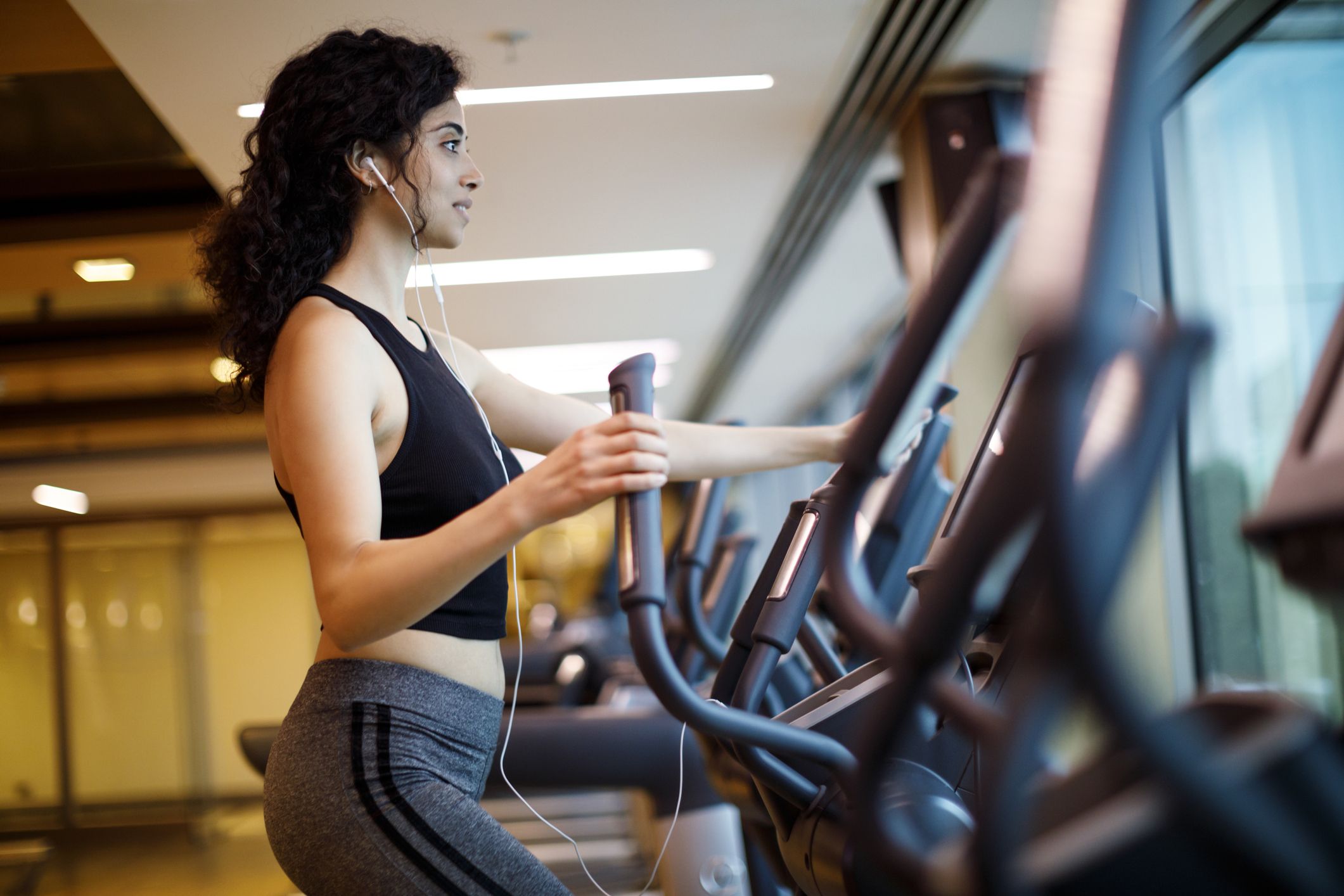
Don’t be fooled by the elliptical. It might look an easy machine, casually spinning your legs while watching TV or reading a magazine. But if you crank up the resistance and work at a hard pace, it’ll leave you breathless.
“Riding the elliptical at an easy clip will not do much, but magic happens when the lungs start working and the blood starts pumping,” Ryan says.
Be sure to stand up straight to lengthen your abs and engage your upper-body muscles. Making use of the handles and swinging your arms will help you burn more calories.
Dorset adds that machines like the elliptical are a good option to keep the weight loss going while protecting your body from extra stress.
“The elliptical is great for providing lower impact while maintaining fitness,” Dorset says. “It’s particularly good for helping prevent injury at the onset or for coming back to running when recovering from an injury.”
TRY working out like Jennifer Aniston: As reported by Vogue, the Friends star likes to hit the elliptical for 20 or more minutes. She’ll raise the incline, then alternate between walking for one minute and running for two minutes.
11. Stairs

No matter how fit you are, climbing up a flight of stairs is always a challenge. That’s because steps are designed to be short so that you have to engage additional muscles, like your glutes, quads, and calves, to bring your entire body up.
“The StairMaster offers a great way to strengthen the glutes, quads, and hamstrings. Working the biggest, strongest muscles in the body keep your metabolic rate high, and your body strong and toned,” Ryan says.
So, climb a set of stairs or try out a StairMaster machine next time you’re at the gym.
TRY a HIIT StairMaster workout: Work your way from a comfortable, moderate pace to an all-out effort.
12. Battle Ropes
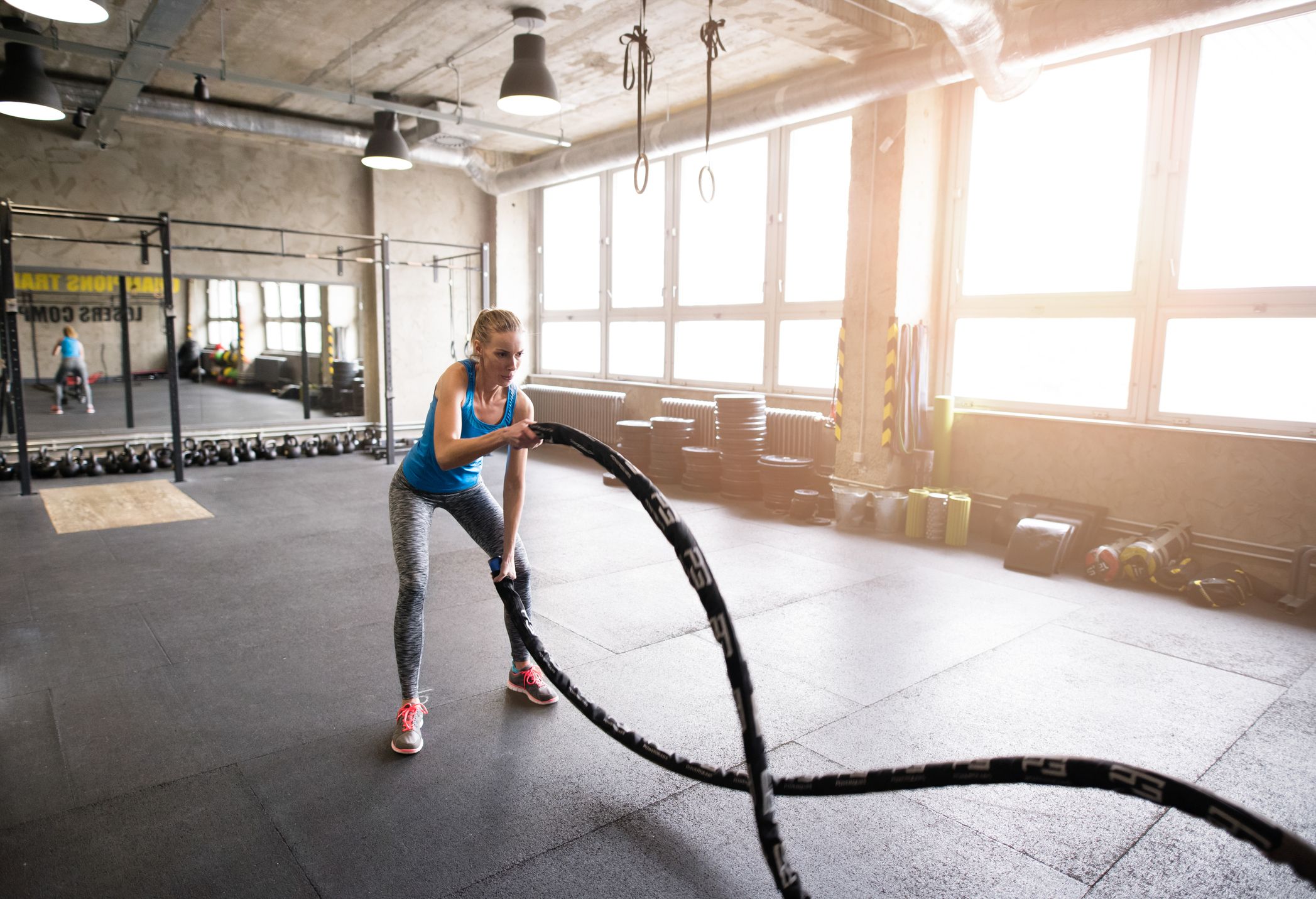
Battle ropes are an excellent, no-fuss way to get a full-body strength training and cardio workout. Working at a high intensity, battle ropes will increase your heart rate in seconds.
“There is something extremely fun and satisfying about slamming heavy ropes repeatedly,” Ryan says. “It not only burns the lungs and muscles in the best way possible, but it also offers a sense of accomplishment by taking out anything that has been bothering you throughout the day.”
To use them properly, hold one end of the rope with each hand and stand with your feet shoulder-distance apart. Bend your knees slightly and keep your chest up as you alternate whipping your arms to send waves down to the rope anchor. Experiment with different tempos and movement, whipping faster with one arm while slamming the rope hard with the other.
TRY this 15-minute routine: Start with making alternating waves with each arm. For the next five minutes, try to maintain these waves. Don’t worry about speed or intensity. Just try to endure. Try this for another two rounds. Rest one minute in between rounds.
13. Swimming
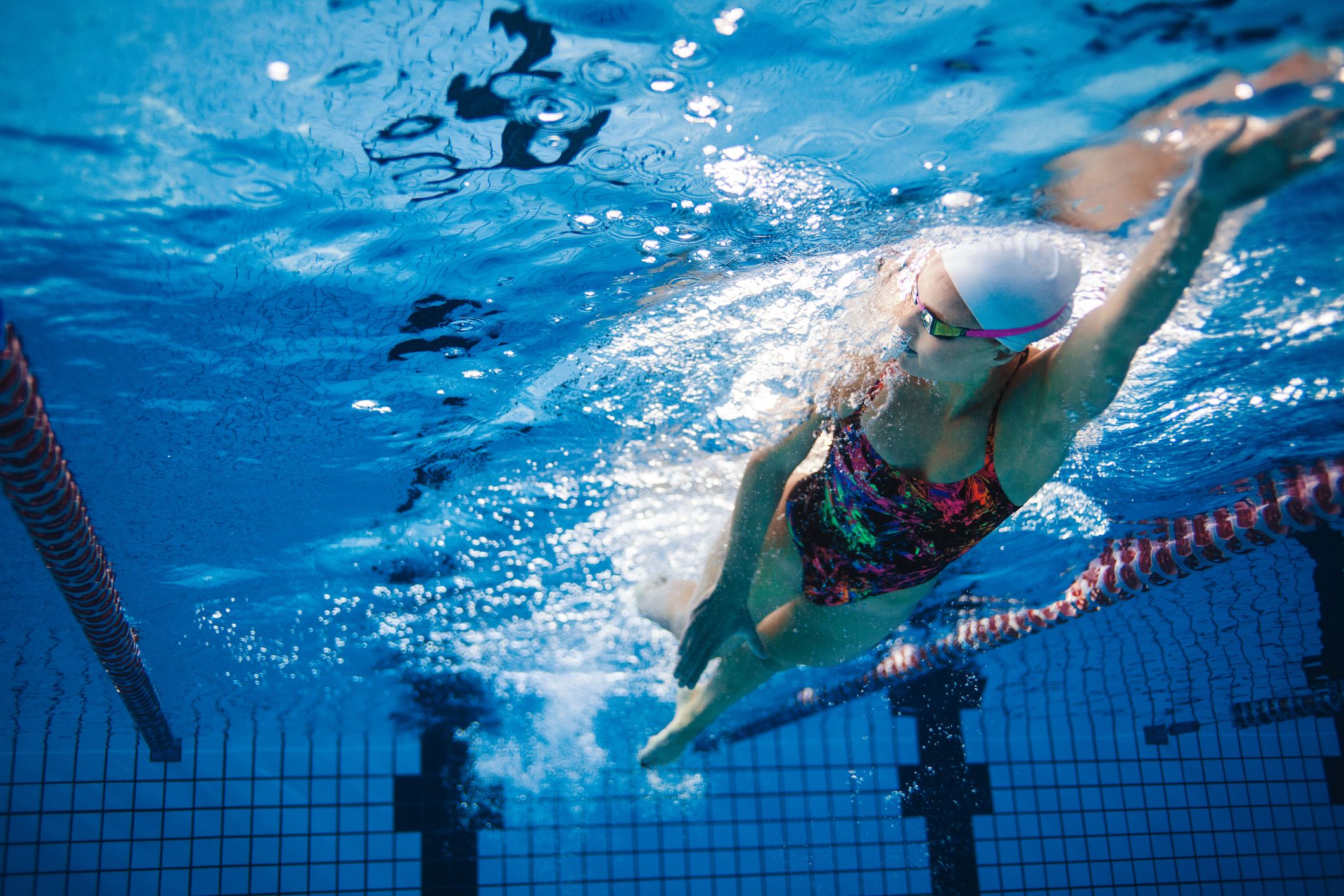
If you don’t enjoy the pounding effects of running on your body, swimming is an excellent workout that combines cardio with strength training in one low-impact workout.
Water adds an element of resistance, forcing you to recruit more muscles to move efficiently and use oxygen wisely.
Need more motivation to hit the pool? Simply being in water around 25 degrees for your workout helps to burn even more calories than on land because your body’s natural temperature is higher. It fights to keep itself warm in water by burning kilojoules and fat, Ryan says.
You’re also using your legs, arms, and core to help you stay afloat, making swimming a great total-body exercise for building strength and endurance.
TRY our swimming workouts for every level.
14. Yoga
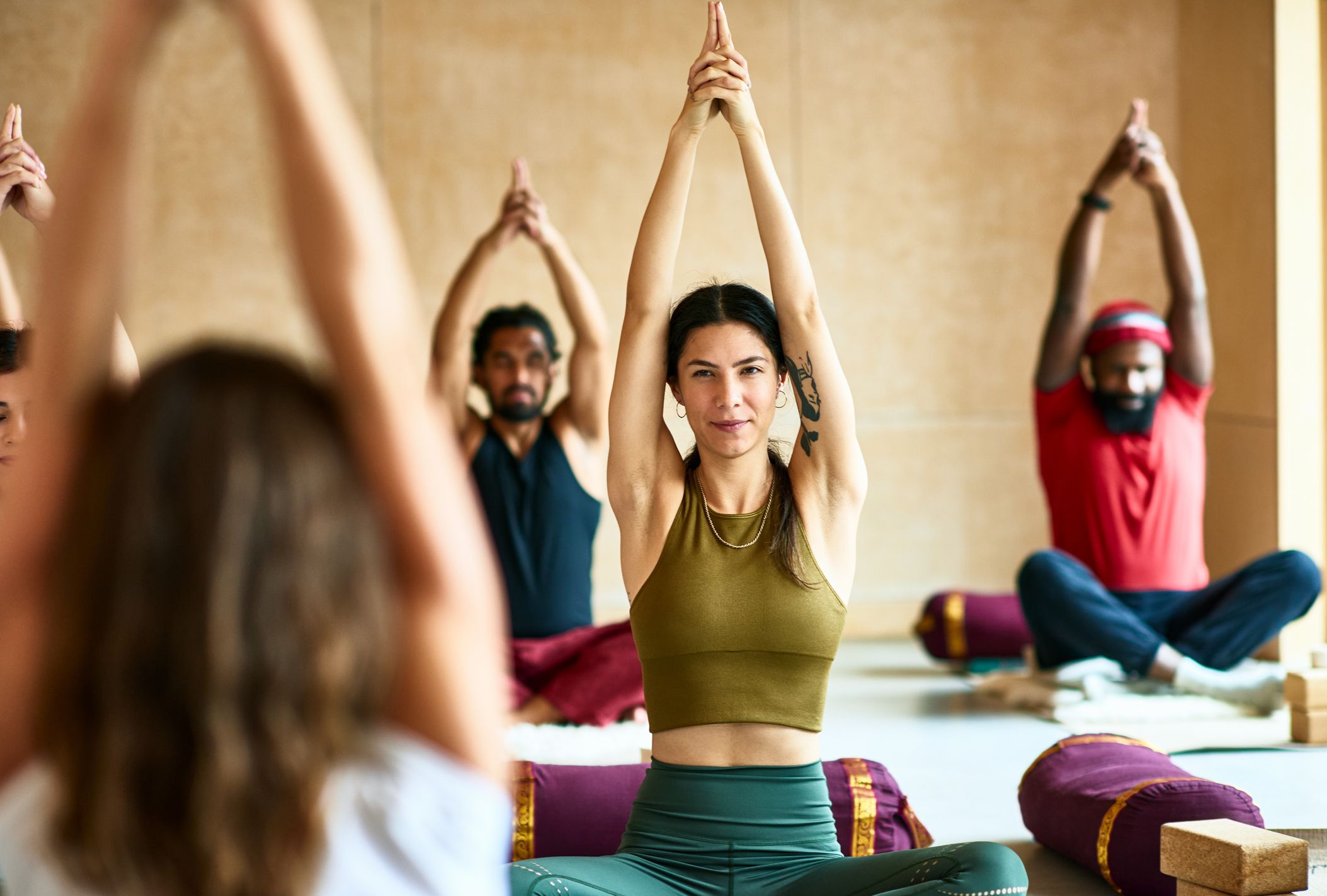
Yoga is an ideal low-impact exercise for weight loss. High cortisol levels can lead to weight gain, and research shows that yoga can help decrease stress.
Plus, yoga increases flexibility, strength, and coordination. If you’re on a mission to lose weight, a consistent practice can help you slim down when paired with a balanced diet.
If you’re looking for an extra way to burn calories during your yoga practice, take up a power yoga class in a hot studio. Not only will you burn more calories while you sweat, but power moves and faster vinyasas will help you get toned.
TRY this easy yoga workout with Jillian Pranksy.
15. Pilates
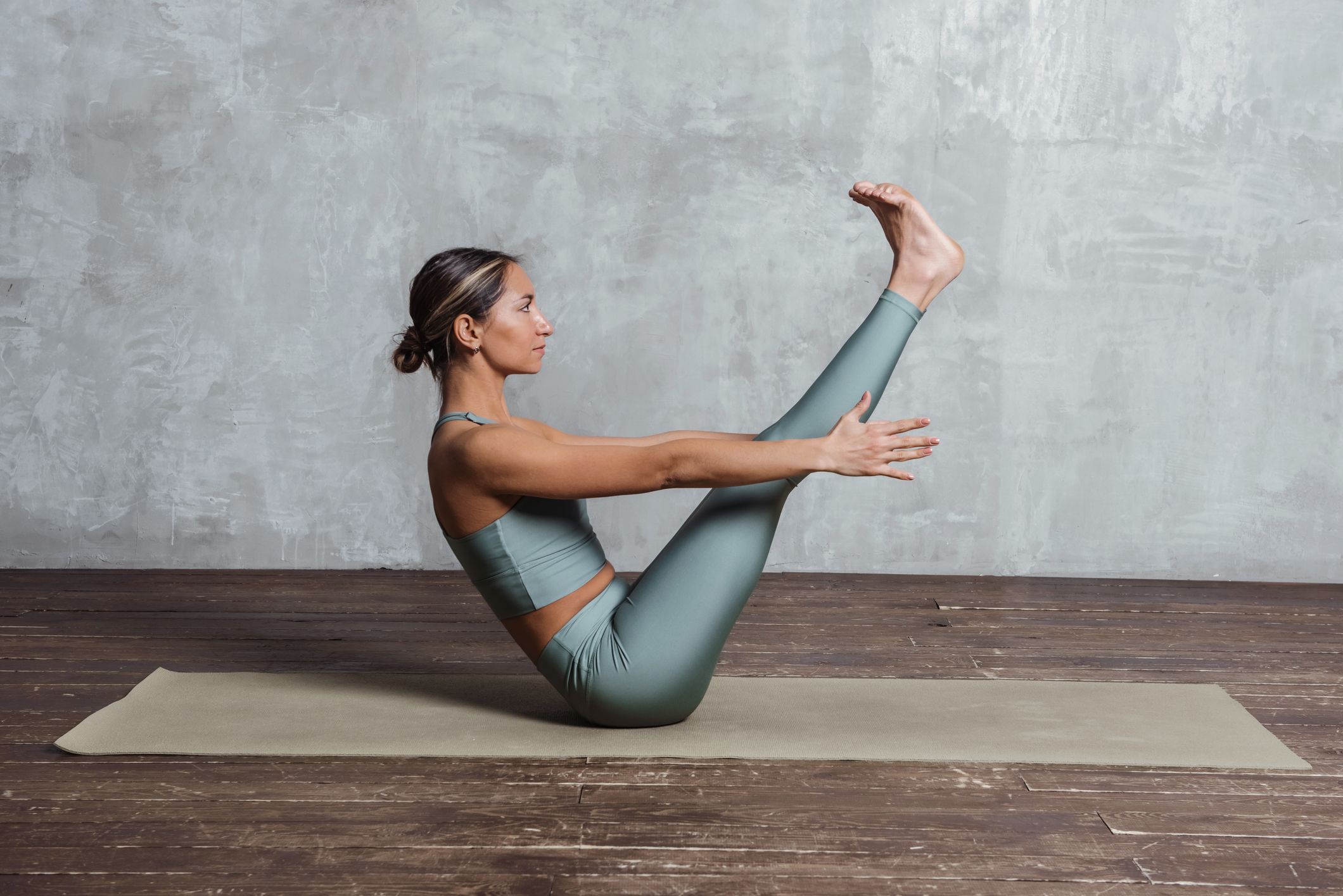
Pilates is similar to yoga, but focuses more on strength. It’s a great form of exercise, according to White, who notes that the challenging moves have lots of benefits including improved flexibility, balanced muscular strength, enhanced muscle control of your back and limbs, and mental benefits.
It also promotes “increased muscle strength and tone in your abdominal muscles, lower back, hips, and buttocks,” White explains.
TRY these simple pilates exercises to flatten your belly.
16. Interval training

If you’re doing lots of cardio (i.e. walking or running) without the results you’re looking for, experts say interval training—or alternating between short bursts of intense effort and periods of lower intensity or rest—may help.
Why? Because muscles are metabolically active, so they burn calories even when you’re not exercising.
Working out in intervals is one way to reap the benefits of cardio and strength, while maximising your calorie burn in a short amount of time. The intensity resets your metabolism to a higher rate during your workout, so it takes hours for your body to cool down again.
That means you burn calories long after you’ve finished your workout compared to doing a workout at a continuous moderate pace (a.k.a. LISS), according to a 2017 study from the European Journal of Applied Physiology.
“Intervals are a great way to promote weight loss. A lot of weight loss comes from the mental side of the spectrum too,” says Ryan. “Intervals offer a great way to harness individual victories after each rep or round of exercise—and not simply looking at the workout as a whole.”
TRY it: If you’re working out in intervals, do your chosen exercise for 30 seconds every minute and rest for the remaining 30 seconds. As you progress, you can increase your time to 45 seconds of activity and 15 seconds of rest. Remember, you want to be working at your maximum—leaving you out of breath by the end of that interval.







.jpg&h=193&w=250&c=1&s=1)
